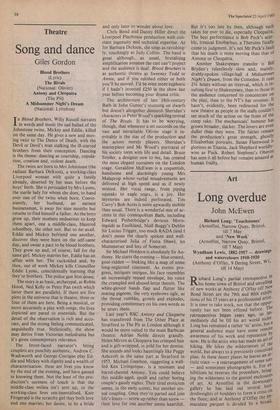Art
Long overdue
John McEwen
Richard Long's partial retrospective in his home town of Bristol and unveiling of new works at Anthony d'Offay off Nov. Bond Street are the 79th and 80th exhibi- tions of his 15 years as a professional artist. It is time to take stock, not that the oPP°r" tunity has not been offered before. The retrospectives began years ago, so 1111. mediately did he fill his art world niche. Long has remained a rather 'in' artist, but a general audience must have some remote awareness of his work and reputation by now. He is the artist who has made an art of hiking. He hikes the wildernesses of the world, but always to a previously conceived plan. In these desert places he leaves an ar- tistic trace — a rearrangement of some sort — and sometimes photographs it. For ex- hibitions he reverses the procedure, briD8' mg the wilderness to the genteel enclosures of art. At Arnolfini in the downstairs gallery he has laid out several hun- dredweights of boulders to form a cross on the floor; and at Anthony d'Offay the im maculate parquet is divided by a broad,
neatly defined, line of flints. In both he has handslapped mud circles on the walls. There are also the recording photographs and, a more recent innovation, the parallel record of his plans and observations verbal- ly presented on large, pasted up, sheets of paper.
Long's work must surely be considered okay as far as it goes — but how far is that? Many contemporary pundits would say very far indeed. These exhibitions should give them pause for thought. In the book (not a catalogue) accompanying the Arnolfini exhibition both Long and his introducer, the artist Michael Craig-Martin, are at Pains to point out that his work is not 'romantic'. On the contrary, according to Craig-Martin his art is classical, only to do with mathematical order and clarity of ex- pression, nothing to do with woolly mystification or derivation. They protest the point because, of course, to Long's cost it just will not wash. Calling him a classicist Puffs up his reputation by protecting him from vulgar comparison and the dimin- ishing effect of general contexts, both of which, ironically, serve to demystify his importance. The fact is that if romanticism is held to include both notions of the cleans- ing power of nature and a degree of spiritual mystification, then Long's artistic Procedure qualifies on both counts. Not on- ly has he gone back to nature, but he spills religion as he goes. His art, seen in the general context of its Sixties origins, can be seen to trade beneficially on a cultural movement which embraces everything from auckminster Fuller's revivalism through Friends of the Earth and fibre dieting to the Californian poetry of Zen backwoodsmen and English inquiries into the ley systems and wizardry of pre-Roman Britain. Long surely has visual gifts — an eye for scale as well as metaphor — but his range is small. By trying to extend it — into paint- ing, into poetry — he only succeeds in fur- ther drawing attention to its limitations. ofrile mud paintings disregard recent pic- torial precedents (from Miro, from Johns) to their cost; his observations fall limply between logbook entries and haiku poems.
including his gear, for the first time, remystify where presumably they are Meant to demystify. It is surely time for him to exhibit less and ponder more. A small but choice selection of drawings and watercolours by Wyndham Lewis fills the two rooms of the smaller d'Offay Gallery, Lewis's Vorticism may be art- historically down-graded as an English satellite of Italian Futurism out of Parisian Cubism, but in his hands, it can have a hardness and beauty of its own. The highly abstracted 'Design for Red Duet', oddly titled since it is almost entirely painted a slate blue, is a particularly fine 1915 exam- _,1e. There are also some good post-war ,c_irawings, in which the robotlike element in his figures is softened in favour of conven- tional representation, with no slackening in the tension of the line. At his sensual and incisive best he is surely as good a draughtsman as we have produced this cen-
tury, his pen serving as a sword. In terms of artistic 'wets' and 'drys', d'Offay usually caters to the Bloomsbury 'wets', but here amends are made by celebrating the driest of the 'drys' in a two-part survey, the second scheduled for next year.











































 Previous page
Previous page